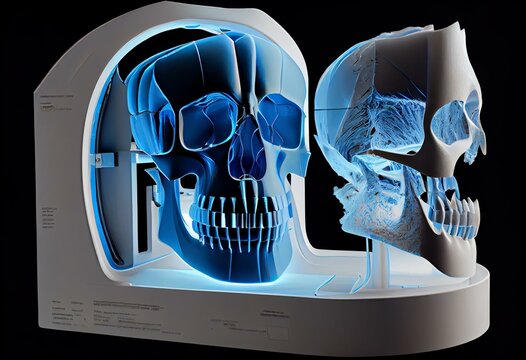CBCT Industry Is Dominated By Dentsply Sirona, Philips, & Vatech With More Than 45% – Know Why

Strong 8k brings an ultra-HD IPTV experience to your living room and your pocket.
Introduction:
Cone Beam Computed Tomography (CBCT) has become a cornerstone in modern dentistry, particularly in orthodontics, where it enables precise imaging for diagnosis and treatment planning. This technology provides detailed, three-dimensional images of the teeth, soft tissues, and bone structures, allowing dentists to assess complex dental conditions more effectively. Over the years, the CBCT industry has experienced significant growth, largely driven by advancements in imaging technology and the increasing demand for dental solutions. Major players in the CBCT industry, such as Dentsply Sirona, Philips, and Vatech, dominate the market with a combined share of more than 45%, solidifying their positions as leaders in this space. In this article, we will explore the reasons behind their dominance and delve into how CBCT is transforming personalized orthodontic treatments.
What is CBCT and Its Role in Dentistry?
Cone Beam Computed Tomography (CBCT) is a medical imaging technique that captures three-dimensional images of the dental and maxillofacial regions. Unlike traditional CT scans, which use a fan-shaped X-ray beam, CBCT uses a cone-shaped beam to capture multiple X-ray images from different angles, which are then reconstructed into a 3D model. This provides highly detailed, accurate images of the teeth, bones, and surrounding tissues, offering valuable insights for diagnosis and treatment planning.
CBCT has become indispensable in modern orthodontics, periodontics, oral surgery, and implantology, offering superior image quality over conventional 2D X-rays. It helps dental professionals assess a patient’s unique anatomy in greater detail, facilitating more accurate diagnoses and treatment planning. For orthodontists, CBCT’s precision allows them to tailor treatments to the specific needs of individual patients, improving both outcomes and patient satisfaction.
Why Dentsply Sirona, Philips, and Vatech Lead the CBCT Market
The CBCT industry is currently dominated by three major players—Dentsply Sirona, Philips, and Vatech—who collectively hold over 45% of the global market share. Their dominance can be attributed to several factors, including their extensive product offerings, advanced technology, and strategic collaborations with dental professionals and institutions.
Download FREE Sample of CBCT Market
1. Dentsply Sirona: Leading Innovation in CBCT
Dentsply Sirona, a global leader in dental equipment and technologies, has made significant contributions to the development of CBCT systems. The company offers a wide range of CBCT imaging solutions, including the popular Orthophos series, which is known for its high-resolution imaging and user-friendly design. Dentsply Sirona’s CBCT systems are equipped with advanced features such as dose reduction technologies, allowing for accurate imaging with minimal radiation exposure.
Dentsply Sirona’s continued focus on innovation has helped it maintain a strong market position. The company invests heavily in research and development to improve the functionality and precision of its CBCT systems, which are widely used in both diagnostic and treatment planning applications. Their solutions are highly sought after by dental practices and hospitals worldwide due to their reliability, ease of use, and the ability to provide comprehensive diagnostic data.
2. Philips: Advancing CBCT Technology for Comprehensive Diagnosis
Philips is another dominant player in the CBCT market, with its line of advanced imaging systems offering comprehensive solutions for dental professionals. The company’s CBCT products are designed with a focus on providing high-quality images while ensuring patient comfort. Philips’ Imaging solutions are widely recognized for their reliability and performance in clinical settings, including both diagnostic and therapeutic applications.
Philips’ strategic emphasis on developing compact, efficient, and cost-effective CBCT machines has contributed to its dominance in the market. Their commitment to enhancing the accuracy of dental imaging, combined with features such as faster scan times and lower radiation doses, has made their CBCT systems a preferred choice among orthodontists and dental surgeons.
Moreover, Philips integrates their imaging systems with advanced software for enhanced treatment planning and patient care. Their solutions provide high-definition 3D imaging and advanced analytics, helping dental professionals make better-informed decisions. With an increasing number of dental practices opting for Philips CBCT systems, the company’s strong brand presence and technological expertise continue to drive growth in the industry.
3. Vatech: Pioneering in Compact and Affordable CBCT Solutions
Vatech, a South Korean company, is renowned for its innovative and cost-effective CBCT solutions. Vatech’s commitment to making dental imaging more accessible to a wider range of dental practitioners has positioned it as a leader in the global market. The company offers a variety of CBCT models, including compact, portable options that are particularly appealing to small and mid-sized dental clinics.
Vatech’s solutions are known for their high-quality images and low radiation exposure, making them ideal for use in orthodontics, implantology, and oral surgery. The company also focuses on providing intuitive software that integrates seamlessly with its CBCT machines, offering practitioners easy-to-use tools for treatment planning and diagnostic evaluation.
Vatech’s competitive pricing and commitment to quality have made it a popular choice among dental professionals, especially those in emerging markets. Their ability to deliver advanced imaging technology at a fraction of the cost of other systems has contributed to their growing market share and strong presence in the global CBCT landscape.
CBCT's Contribution to Personalized Orthodontic Treatments
One of the primary drivers behind the growing adoption of CBCT technology in dentistry is its ability to support personalized orthodontic treatments. Traditional 2D X-rays have long been the standard in orthodontics, but they offer limited information about the three-dimensional structure of the patient’s teeth, bones, and surrounding tissues. CBCT, on the other hand, provides highly detailed 3D images that enable orthodontists to assess the anatomy of the patient in greater detail, ultimately leading to more tailored and effective treatment plans.
1. Precision in Diagnosis
CBCT’s 3D imaging allows orthodontists to obtain a comprehensive view of the patient’s dental and skeletal structures. This detailed information helps clinicians diagnose conditions such as impacted teeth, temporomandibular joint disorders (TMJ), and malocclusions with greater accuracy. In orthodontics, understanding the precise positioning and alignment of the teeth and jaw is critical for developing effective treatment strategies. CBCT enhances diagnostic capabilities, leading to more accurate assessments of malocclusions and better planning for treatments like braces or clear aligners.
2. Optimized Treatment Planning
The detailed 3D models created by CBCT scans allow orthodontists to visualize the relationship between the teeth, bones, and soft tissues in a way that traditional 2D X-rays cannot. This enables the creation of more customized treatment plans that take into account the unique anatomy of each patient. For instance, in complex cases where teeth need to be moved into precise positions, CBCT provides the necessary information to ensure that movements are planned in the safest and most effective manner possible.
CBCT imaging also facilitates the use of digital planning software, which can simulate various treatment scenarios, helping orthodontists choose the best approach based on the patient’s unique anatomy. This leads to improved treatment outcomes, fewer complications, and a reduction in the time required to achieve the desired results.
3. Enhanced Patient Experience
Personalized orthodontic treatment based on CBCT images not only improves clinical outcomes but also enhances the patient experience. With more precise treatment plans, patients can expect faster, more comfortable treatments. Additionally, the ability to visualize their treatment progress through 3D images helps patients feel more involved in the process, increasing their satisfaction and engagement.
Furthermore, CBCT technology can assist in planning for other dental treatments such as implants and oral surgeries, allowing orthodontists to coordinate treatments more effectively and ensure optimal results for the patient.
The Future of CBCT in Orthodontics and Dentistry
The CBCT industry is poised for continued growth as technological advancements lead to more efficient, affordable, and user-friendly systems. The integration of AI and Machine Learning into CBCT imaging is expected to further enhance the accuracy and predictive capabilities of these systems, providing even more personalized treatment options for patients.
Download FREE Sample of Machine Learning Market
The growing demand for orthodontic treatments, coupled with the need for more advanced imaging technology, will continue to drive the CBCT market. As more dental professionals and clinics embrace CBCT, the industry’s dominance by leaders like Dentsply Sirona, Philips, and Vatech will likely persist. With ongoing innovation and a focus on improving patient outcomes, CBCT will remain a central tool in modern dentistry, particularly in orthodontics.
Conclusion
The CBCT industry is dominated by key players such as Dentsply Sirona, Philips, and Vatech, who collectively hold a significant share of the market. Their dominance can be attributed to their innovative technologies, extensive product portfolios, and commitment to advancing the field of dental imaging. CBCT’s ability to support personalized orthodontic treatments is revolutionizing the way dental professionals diagnose and treat patients, enabling more accurate and effective care. As the demand for personalized, precision-based treatments grows, the importance of CBCT in orthodontics and other dental disciplines will continue to rise, shaping the future of dentistry.
Read the complete blog
Note: IndiBlogHub features both user-submitted and editorial content. We do not verify third-party contributions. Read our Disclaimer and Privacy Policyfor details.


